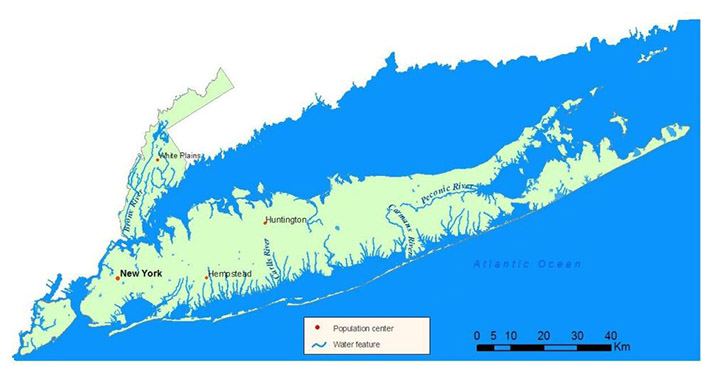Courtesy of the Department of Environmental Conservation
The Long Island Sound is located between Long Island and Connecticut.
By Forum Staff
The bipartisan Long Island Sound Restoration and Stewardship Act has unanimously passed out of the Senate Environment and Public Works Committee and is now headed to the full Senate for a vote, U.S. Sen. Kirsten Gillibrand (D-N.Y.) recently announced.
The legislation, sponsored by Gillibrand, would combine two complementary water quality and shore restoration program authorizations at their previous authorization levels of $40 million and $25 million per year, respectively, through Fiscal Year 2023. The legislation would also support various projects to upgrade wastewater facilities, wetland protection and restoration, and non-point source pollution control to further protect and restore the Sound and watershed.
In 1985, the U.S. Environmental Protection Agency, in an agreement with New York and Connecticut, created the Long Island Sound Study, an office under the EPA charged with advancing efforts to restore the sound and address low oxygen levels and nitrogen levels that have depleted fish and shellfish populations as well as hurt shoreline wetlands. In 1990, the Long Island Sound Improvement Act passed, providing federal dollars to advance Sound cleanup projects, including wastewater treatment improvements.
In 2006, Congress passed the Long Island Sound Stewardship Act, which provided federal dollars for projects to restore the coastal habitat to help revitalize the wildlife population and coastal wetlands and plant life. Since then, for every $1 appropriated, the LISS has leveraged $87 from other federal, state, local, and private funding sources, totaling more than $3.8 billion. The funding has enabled programs to significantly reduce the amount of nitrogen entering the Long Island Sound from sewage treatment plants by 42,000,000 pounds per year as of 2015, compared to the 1990s, and has helped restore at least 1,548 acres and protect 2,580 acres of habitat land.
“The Long Island Sound is one of our most important natural treasures, and is a vital economic anchor that supports thousands of local jobs,” Gillibrand said. “Maintaining these authorization levels would help protect the long-term health of the Sound and help promote economic development in the area. Now that this legislation is heading to the full Senate for a vote, I am urging my colleagues to pass this legislation to build on the ongoing efforts to restore the Sound for generations to come.”
According to Gillibrand, the L.I. Sound borders New York and Connecticut, with 9 million people living on the coast and 24 million people living within 50 miles of the coast. Although decades of high levels of development, pollution, dumping of dredged materials, and releases of untreated sewage have severely hurt the Sound’s water quality, the Sound’s economic contribution, including from sport and commercial fishing, boating, recreation, and tourism is estimated to be between $17 billion and $37 billion annually.
“The Long Island Sound is a natural treasure and an economic engine for the whole region that draws families, boaters, tourists and anglers to our shores. This legislation will make sure we have the federal funds necessary to help restore and protect the beaches and waters in and around the Long Island Sound for current and future generations,” added Senate Minority Leader Charles Schumer.

